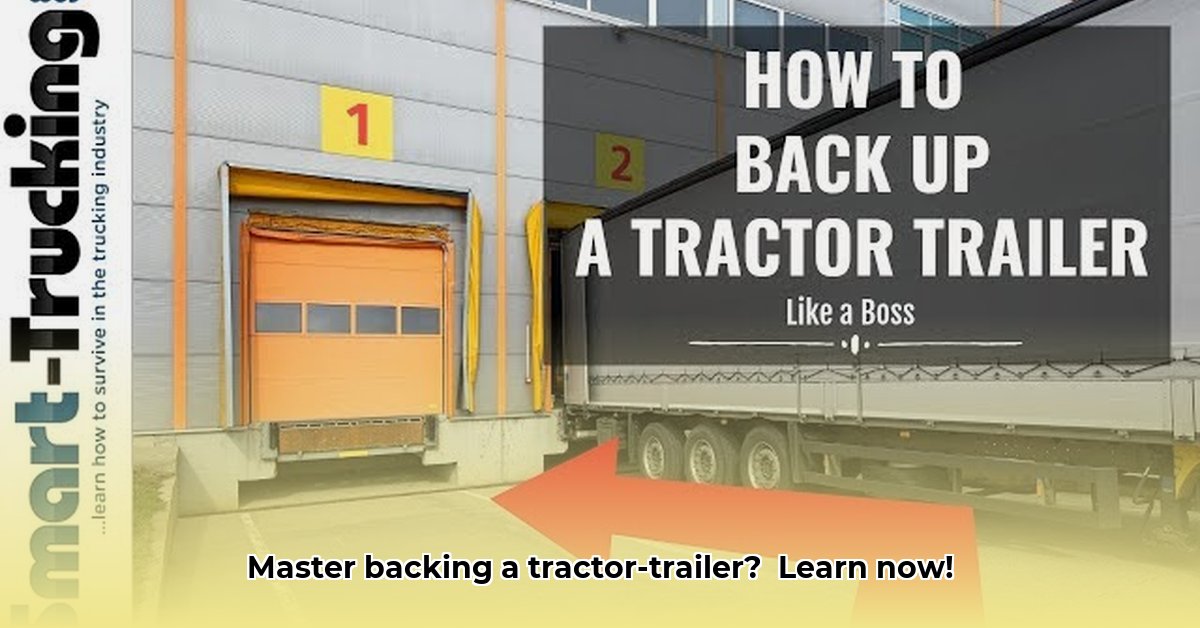
Backing up a tractor-trailer is a crucial skill for professional drivers, demanding precision, patience, and a thorough understanding of vehicle dynamics. While challenging, mastering this skill is achievable through diligent practice and adherence to safety protocols. This guide provides a step-by-step approach, transforming you from novice to confident backer. For more advanced techniques, check out our guide on double clutching.
Pre-Maneuver Checks: The GOAL Method and Beyond
Before initiating any backing maneuver, the GOAL method—Get Out And Look—is paramount. Exerting this step is not optional but mandatory. Exit the vehicle and conduct a complete visual inspection of your surroundings. Identify potential obstacles (other vehicles, pedestrians, uneven terrain, low-hanging objects), assess available space, and determine the necessary maneuvering room. Insufficient space can lead to accidents. Does the space you have appropriately accommodate the length of your trailer? Failing to do this adequate check may end with tragic results.
Beyond GOAL, several crucial pre-checks enhance safety:
- Cargo Securement: Verify that your load is properly secured to prevent shifting during the maneuver. A shifting load dramatically increases the risk of accidents and delays.
- Mirror Adjustment: Ensure your mirrors are correctly adjusted for optimal visibility, minimizing blind spots. Adjust them to see as much space around the truck as possible to prevent accidents.
- Blind Spot Assessment: Even with adjusted mirrors, significant blind spots exist. Consider if a qualified spotter is necessary, particularly in complex situations. A spotter can significantly reduce accident risks.
Mastering Basic Backing Techniques: Straight Line and Alley Dock
These fundamental techniques lay the groundwork for more complex maneuvers.
Straight-Line Backing
- Positioning: Position your truck to ensure a clear, straight path to your target.
- Slow and Steady: Initiate backing slowly, avoiding jerky movements. Speed kills in backing up.
- Mirror Usage: Constantly monitor your surroundings using mirrors, making small, controlled steering adjustments.
- Corrective Steering: If drifting occurs, steer gently in the opposite direction to correct your course. Small corrections are far more effective than abrupt ones.
Alley Docking
Alley docking involves backing into a space confined by obstacles on both sides. The principles remain the same, but increased precision is required.
- Approach: Position yourself for a smooth entry, minimizing the need for large corrections.
- Steering Control: Use small, incremental steering inputs to guide the trailer into the desired space. Maintain a slow speed and constant monitoring of your surroundings.
- Final Adjustment: Fine-tune your positioning once you are largely in the space. Remember: patience is paramount.
Tackling Advanced Challenges: Parallel Parking and Jackknife Recovery
Parallel Parking
Parallel parking a semi-truck necessitates exceptional precision and considerable practice.
- Planning: Carefully assess the parking space and visualize the maneuver before starting.
- Steering Inputs: Use small steering corrections, guided by mirror observations, to position the truck and trailer accurately.
- Patience: Expect this maneuver to take time; multiple attempts are normal, especially when starting.
Jackknife Recovery
A jackknifed trailer presents a serious hazard. Respond calmly and deliberately.
- Immediate Slowdown: Avoid acceleration; gently apply brakes to reduce speed.
- Assessment: Evaluate the situation, identifying obstacles and the available maneuvering space.
- Controlled Corrections: Use small, gradual steering corrections to realign your truck and trailer. Avoid abrupt movements.
Safety Protocols: Spotters, Signals, and Regulations
Always utilize turn signals and your horn to alert others of your intentions. A qualified spotter significantly enhances safety, particularly in tight spaces. However, ensure clear communication and understanding between you and the spotter. Always comply with all relevant traffic laws.
Troubleshooting Common Problems
Getting stuck or experiencing a jackknife can happen. Remain calm and reassess the situation. Consider repositioning or seeking assistance if needed.
Practice and Continuous Improvement
Consistent practice in a safe environment is critical for developing proficiency. Regular practice builds muscle memory and enhances confidence. Many professional drivers continually refine their backing techniques through dedicated practice.
Conclusion: The Road to Mastery
Becoming a proficient tractor-trailer backer requires dedication and practice. Prioritize safety, continually refine your skills, and remember that even experienced drivers benefit from ongoing practice. Mastering this intricate skill transforms you into a safer, more efficient professional whose actions help prevent accidents. Remember, practice, patience, and safety are the cornerstones of success.